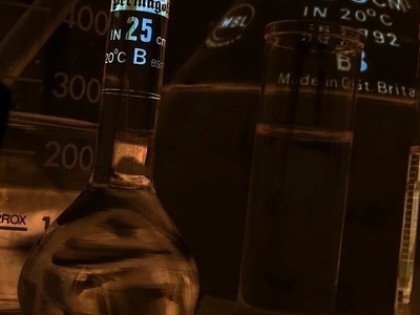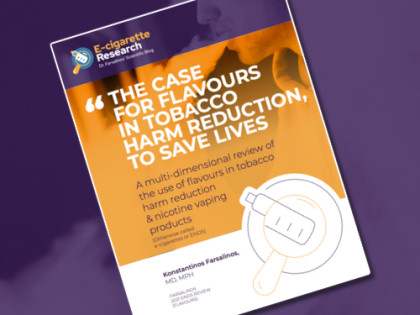Our original story included rebuttals from medical practitioners and vaping advocates. Clive Bates said at the time: “This study is so poorly designed and inherently misleading that it should not have been conducted, should not have been written up, should not have been published in the NEJM or anywhere, should not have been pitched to the media, and its finding should be completely ignored as worthless.”
David Peyton, Portland’s lead researcher, later expressed his shock at the way their study had been portrayed in the media. He explained that the team never set out to demonise ecigs.
The first letter in the NEJM was from Doctors Joel L. Nitzkin, Konstantinos Farsalinos and Michael Siegel. In it they begin by pointing out that the data presented by the Portland team does not support the conclusion - that electronic cigarette use presents a likely risk of excessive exposure to formaldehyde.
“The 5 volt puff topography used by Jensen et al. appears to have overheated the coil, resulting in excessive breakdown of propylene glycol to formaldehyde,” they expounded. They explain that the dry hit phenomena we’ve all encountered at some point while vaping is not a thing we endure. “The consumer can address this issue by discontinuing use ... or reducing puff duration while increasing the interval between puffs,” they explained. “Thus, taste prevents e-cigarette users from exposing themselves to excessive formaldehyde from overheating of the coil.”
Richard Thomson and Philip Lewis wrote to address the concerns they had over the misleading comments regarding vaping voltage. The research gave the impression that it was a higher voltage which resulted in excess formaldehyde production whereas Thompson & Lewis point out: “Importantly, the magnitude of temperature increase is related to the total power dissipated in the element, a product of both the applied voltage and element resistance.”
They gave the following example: “Applying 3.3 V to a 0.5-Ω element would produce 21.8 W of dissipated power, whereas the same voltage applied to a 3.0-Ω element would produce just 3.6 W. The surface area of the element and differences in conductive heat loss further complicate the issue. We should therefore caution readers against assuming that 3.3 V is ‘more safe’ and that higher voltages are ‘less safe.’”
The final letter, from Sandeep Sodhi and Amardeep Khanna concerns the actual toxic potential of ecigs. They note that the levels of carcinogens in cigarettes are considerably higher than found in ecigs and posed the questions: “Is formaldehyde (whose vaporized carcinogenic effect is still not known) safer in the context of short-term usage? Is the risk it poses less than the cumulative risk of cigarette constituents? If low-voltage, 0%-nicotine e-cigarettes are used during the weaning from cigarettes, can the benefits outweigh the risk of the presence of formaldehyde?”
The Portland researchers replied that although their investigation tested for extremes in voltage it is probably that elevated levels of formaldehyde can be produced and not be detected through bad taste. They also explained that different people may exhibit a different tolerance for bad taste and gave an example of cigar smokers, some will inhale and some will not.
“We agree with Thomson and Lewis,” they said, “that more than voltage is important: coil resistance is of fundamental significance in determining the power delivered and the temperature achieved. Other important factors include device geometry, liquid flow in the wick, catalytic actions, and airflow.”
In response to Sodhi and Khanna they stated: “It will probably take at least a decade for the public health consequences of long-term vaping to be even partially understood; In the meantime, a reasonable approach is to quantify individual toxicants and the conditions that generate them and to evaluate possible outcomes. From a public health perspective, we think the questions are, ‘What is the full toxicologic terrain of the vaping process?’ and ‘Can ENDS be better designed to be safer?’”
Dave Cross
Journalist at POTVDave is a freelance writer; with articles on music, motorbikes, football, pop-science, vaping and tobacco harm reduction in Sounds, Melody Maker, UBG, AWoL, Bike, When Saturday Comes, Vape News Magazine, and syndicated across the Johnston Press group. He was published in an anthology of “Greatest Football Writing”, but still believes this was a mistake. Dave contributes sketches to comedy shows and used to co-host a radio sketch show. He’s worked with numerous start-ups to develop content for their websites.
Join the discussion
Experts Dispute Gateway Claim
Leading harm reduction experts have disputed claim that vaping is a gateway to smoking following malicious claims to the contrary from Otago University in New Zealand
Flawed Research
Konstantinos Farsalinos and Riccardo Polosa have published a paper looking at the flawed electronic cigarette research that gets published due to defective peer review process
ANPVU Awards Honorary Membership
Italian consumer group ANPVU has made the decision to award Dr Konstantinos Farsalinos with the appointment of Honorary Member of the ANPVU
The Case for Flavours
Dr Konstantinos Farsalinos has been exceptionally active in making the case for flavours in tobacco harm reduction to save lives including releasing a comprehensive document






-listing400.jpg)




